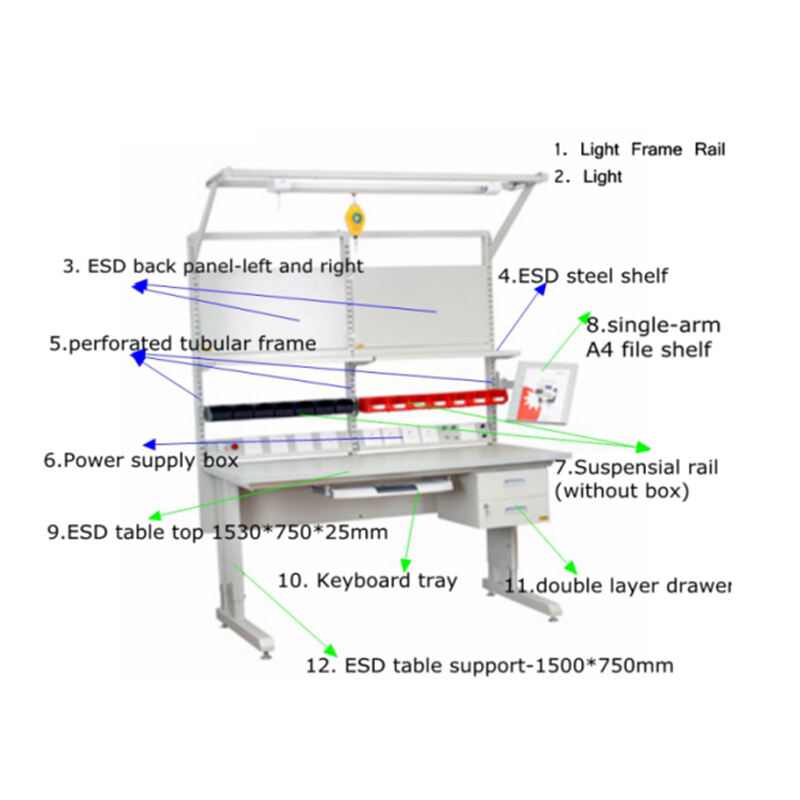EDS presents a critical issue for spaces that process delicate electronic components. Organizations face financial losses starting at thousands of dollars when handlers do not exercise proper care while operating in untrained environments. Workplace safety demands that everyone receives proper training about ESD workstation use. The following article provides information about static-sensitive work practices together with the necessary PPE equipment along with daily inspection protocols.
Best Practices for Static-Sensitive Environments
A static-safe environment constitutes the core procedure for preventing ESD-related damages. The below measures represent best practices which should be implemented:
1.Control Access to ESD-Sensitive Areas: The entrance of ESD-Sensitive areas must be restricted to trained personnel because they are the only workers authorized to operate there. Signs together with barrier systems should be used to limit unauthorized entry.
2.Workstation Grounding: Workers should maintain proper grounding of all their workstation equipment. The required static protection equipment consists of conductive flooring together with grounded wrist straps as well as grounded mats.
3.Humidity Control: In order to minimize static buildup you should maintain a humidity ratio of 40-60% because dry conditions make static buildup worse.
4.Use of Antistatic Materials: The workplace should use antistatic materials such as bags and containers as well as storage equipment to protect sensitive electronic components.
5.Air Ionizers: Air Ionizers together with their capability to counteract static electricity function in settings that resist basic grounding practices.
6.Proper Handling of Components: Employee education consists of receiving proper instruction about handling sensitive components using two-hand techniques for reducing both friction and static charge accumulation.
7.Regular Monitoring: Professional ESD monitoring tools need to assess static build-up in the workplace while maintaining all recorded data.
PPE Requirements
Protecting electrostatic discharge requires Personal Protective Equipment (PPE) as a vital component. PPE demands should include the following requirements:
●Wrist Straps: Wrist straps constitute the most effective way for grounding personnel who need to wear these straps at all times during sensitive component handling. Regular checks should verify the operational status of wrist straps.
●Footwear: A requirement exists for all personnel in static-sensitive spaces to wear ESD-safe shoes together with heel grounders. The grounding devices permit personnel to get grounded to a greater extent.
●Garments: A regular use of ESD-safe lab coats alongside smocks and uniforms reduces the formation of static charges. The grounding system must be established for materials and all garments should contain conductive threads.
●Gloves and Finger Cots: Another important ESD protection solution includes the use of gloves and finger cots that maintain electrostatic discharge safety during conditions where component handling becomes necessary. All such materials need to stay clear of dust and contaminants.
●Headgear: Wear hair covers or ESD caps that serve to stop static energy buildup which stems from hair.
Daily Inspection Checklists
The correct operation of ESD protection measures depends on periodic inspections where all protective equipment is checked for proper installation. The daily checklist for ESD protection measures includes the following verification steps:
1.Workstation Grounding Verification: Check the integrity and correct connection of workstations through grounding verification procedures.
2.Wrist Strap Check: The functionality of wrist straps should be evaluated through tests using an ESD tester. All workers need to follow correct procedures to wear their wrist straps at the workplace.
3.Footwear Inspection: An inspection of ESD footwear should include visual checks for damage while a footwear tester evaluates performance during the process.
4.ESD Garment Check: Every employee must wear their ESD-safe garments as well as maintain their good condition during daily checks.
5.Humidity Level: Electrical workers should verify and record the humidity level in the workspace because optimum levels lie between 40-60%.
6.Daily Cleaning: Workstation evaluation and cleaning of floors and ionizers along with regular cleaning of surfaces takes place daily to eliminate substances that would impact ESD-sensitive operations.
7.Ionizer Operation: Make sure that all ionizers perform their intended operations. Pollution also affects performance of ionizers so inspection validates proper placement of emitter points.
8.Component Storage: All ESD-sensitive components along with tools must be stored in properly designed antistatic bags or containers.
9.Documentation: Complete documentation should include comprehensive inspection records combined with test notes showing date, time and responsible person.
By implementing these best practices, implementing PPE requirements and using a daily inspection checklist, you can reduce the risks associated with ESD and ensure a safe, efficient work environment to handle sensitive electronic components. Proper training and consistent applications of these guidelines will not only protect components, but will also increase overall operating efficiency, to save the costs related to time and ESD-related damage.







